by Tom Read
In the first part of the article that was published recently (see the related items section), Tom took a close look at 23 stats on big tech’s carbon footprint. He did so by first providing an overview of Tech’s Co2 emissions. He then talked about some stats about the best and worst among the Tech industry and consumer electronics. In this second part, he will take closer look at consumer media, search engines and artificial intelligence, emissions in FinTech and e-commerce, and the road to lower emissions.
Consumer Media
Consumer media, such as social media platforms, have become an inextricable part of everyday life across the globe. In this section, we’ll explore the carbon footprints of popular consumer media.
#24: TikTok’s Carbon Footprint Dwarfs Other Social Media Apps
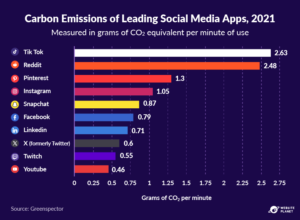
Internet users today spend an average of 151 minutes on social media platforms each day. If one person spent all of these minutes scrolling on TikTok’s news feed, over an entire year, this would amount to 145 kg of CO2 emissions — the equivalent of driving a gasoline-powered car for over 370 miles. Interestingly, despite also being video platforms, the news feeds of YouTube, Facebook, and Twitch all have significantly lower emissions per minute than TikTok, at over 70% less. However, since these platforms typically involve longer videos, they’re likely to have higher total cumulative emissions.
#25: Streaming Music Can Be More Energy Efficient than Traditional Media
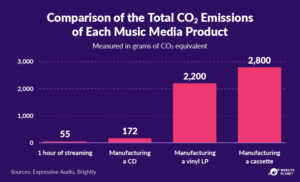
Most social media platforms encourage carbon-intensive activities such as watching videos or chatting in real-time. Music streaming services like Spotify and Apple Music, however, often have a smaller carbon footprint compared to traditional listening means such as CDs or vinyl. Without accounting for the device used to play the CD/vinyl/cassette, streaming 3 hours of music has around the same footprint as the manufacture of a single CD, 40 hours to match the footprint of manufacturing a vinyl record, and 50 to match that of a cassette.
#26: The Impact of Streaming Video Has Often Been Overstated
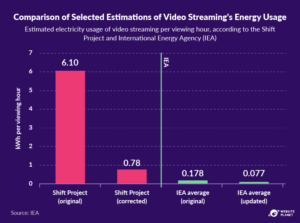
A report from the International Energy Agency (IEA) found that contrary to various mainstream media coverage, the climate impacts of video streaming services were relatively modest when compared with other activities. It cited a 2019 report by the Shift Project, a French think tank, as a particularly misleading report. Shift Project’s report stated that streaming was responsible for more than 300 million metric tons of CO2 in 2018, equivalent to all of France’s emissions. The think tank revised its figures down the following year, acknowledging its original numbers were off by a whopping 8-fold.
#27: Scrolling through Instagram Timelines Comes at a Hefty Environmental Cost
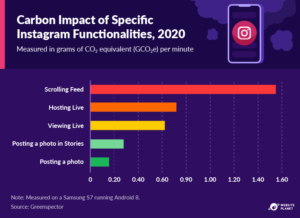
With Instagram’s popularity as a leading social media platform — not just for individuals but also for businesses — its carbon impact should be considered. Scrolling through Instagram timelines is the most energy-intensive feature of Instagram, causing more than twice the carbon impact of the next most intensive feature, live hosting. Going forward, the best ways to address this problem may include Meta moving Instagram to server farms that are powered by greener energy, and user devices moving toward being more energy and data efficient.
Search Engines and Artificial Intelligence
With more and more search engines adopting technologies such as artificial intelligence and privacy features into their infrastructure, the emission cost is significant. Let’s look at some facts and figures surrounding these platforms.
#28: The Rising Carbon Footprints of Popular Large Language Models

The artificial intelligence industry is currently experiencing an emergence of usefulness and popularity. This is particularly true of natural language processing (NLP) models which use deep learning to approximate human speech. To continue developing these models, the sizes of the data sets used to train them are growing rapidly — and their energy consumption and emissions figures are growing exponentially as a result. For instance, depending on the mixture of renewable and non-renewable electricity, GPT-4’s training could have resulted in carbon emissions ranging from 1,035 to 14,994 MtCO2e, which reflects a potential increase of up to 30 times that of its predecessor.
#29: The Last Steps of Tuning an AI Model Are the Most Carbon Intensive
Using neural architecture search to train a natural language processing model can lead to a 3,000x increase in CO2 emissions. Emissions increased from 192 lbs of CO2e to 626,155 lbs of CO2e when neural architecture search was used during the model’s training.
Neural architecture search employs an exhaustive approach to optimising natural language processing (NLP) models. This process demands massive amounts of computing power — so large, in fact, that the emissions created from using neural architecture search are far higher than the yearly emissions of the average human.
Despite this heavy demand on computing power, neural architecture search only offers marginal increases in search accuracy. However, this may well improve over time, with improvements being made in both algorithms and hardware.
#30: ChatGPT’s Popularity Is Causing Its Impact to Skyrocket

ChatGPT’s emergence from relative obscurity in late 2022 has led to a substantial uptick in usage and potentially significant environmental costs. The popularity of the platform may carry with it a steep increase in emissions due to the heightened demand and consequent energy use. Daily usage is one of the key drivers of ChatGPT’s emissions, but it isn’t the only one. Training these models is one of the most substantial costs. For instance, GPT-3’s training is estimated to have consumed 1,287,000 kWh. Meanwhile, GPT-4 is estimated to have required a staggering 52,812,500 kWh. The increase shows how emissions are scaling as AI technology advances.
#31: Not All Search Engines Are Created Equal
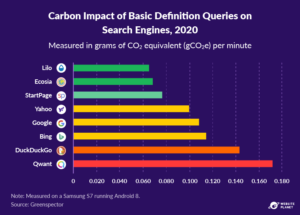
Every search engine is powered by different infrastructure, and this means their emissions vary significantly. On average, an online search has a carbon impact of 0.106 CO2e, roughly equivalent to driving 1 meter in a car. When you consider that Google alone gets around 99,000 search requests every second, or over 8.5 billion requests per day, this figure adds up to an incomprehensibly large number.
DuckDuckGo and Qwant have the highest carbon impacts per search. These two engines prioritise user privacy and demand more memory and resources per search than some of their competitors. On the other hand, Lilo, Ecosia, and StartPage all have very low memory and resource demands to perform a search, giving them a net-low carbon footprint per search.
#32: Using a Mobile App Search Can Lower Your Carbon Footprint
Mobile browser searches emit 64% more carbon on average than searching through an app. In a study, Greenspector found that most search engines are far more energy efficient via their mobile applications, rather than on their browser-based counterparts. This is likely due to the nature of mobile applications, where they’re designed for one specific operating system rather than as a one-size-fits-all variant.
The study also found that some ways users can further reduce their carbon footprints for mobile searches include using autocomplete (for a 14% drop in carbon emissions), using a dark theme (for a 3% reduction), and deactivating news feeds.
Emissions in FinTech and E-commerce
Fintech and e-commerce are booming sectors, and both have a substantial environmental impact. In this section, we break down the quantity and source of these emissions, and how some of the industry’s players are taking the initiative to curtail them.
#33: FinTech Company Tide Becomes First to Remove 100% of Its Carbon Emissions
In 2022, Tide became the first FinTech company to go carbon neutral. The organisation used 3,711 metric tons of durable biochar to remove 100% of its emissions. As an industry, fintech doesn’t have the same heavy physical infrastructure burden as other industries — however, there are still significant carbon footprints associated with the delivery of financial services. The main source of these emissions is the energy required to operate data centers, servers, and physical offices.
By pledging to be fully net-zero emissions by 2030, and having already offset 100% of its emissions, UK-based fintech company Tide has set a high bar for other fintech businesses to meet. It did this primarily through an ongoing investment in decarbonisation and durable carbon removal — a market that’s still nascent, but seeing increased investment across the industry.Hopefully, this is just one example of a trend in the fintech space that will continue over the next few decades.
#34: Bitcoin Emissions Continue to Soar
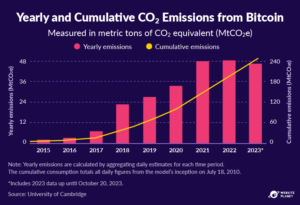
The cryptocurrency industry, with Bitcoin at its helm, continues to be a major contributor to global greenhouse gas emissions. While Bitcoin emissions remained consistent in 2022, they’re estimated to reach an all-time high in 2023, having nearly matched 2022 emissions in just the first three quarters of the year. Some jurisdictions are introducing mandates forcing Bitcoin mining farms to only operate in areas with access to renewable energy. If we see more of this in the coming years, Bitcoin’s environmental impact may be reduced.
#35: Second Largest Cryptocurrency Slashes Virtually All Its Emissions
The second largest cryptocurrency, Ethereum, shifted away from its power- and emission-heavy proof-of-work consensus mechanism to a proof-of-stake mechanism in September 2022.This change meant that it no longer required its miners to perform computationally intensive tasks, reducing the blockchain’s energy usage by 99.988%.
In turn, this reduced Ethereum’s annual emissions from over 11 million metric tons of carbon dioxide — nearly a quarter of Bitcoin’s emissions — to around 870 tonnes of carbon dioxide annually; a 99.992% drop. This was a huge milestone for the industry, and one that many newer cryptocurrencies have taken note of. Several cryptocurrencies have launched with similar models, which don’t require power-intensive mining operations in the way that Bitcoin and other proof-of-work models do.
#36: Large Financial Players Continue to Fund Massive CO2 Emissions
US financial giants funded 2 billion tons of CO2 emissions in 2020. That’s the equivalent of running 432 million passenger vehicles for a year. For nations to meet their climate goals, legislation for large banks to disclose their emissions needs to improve. Despite not including Scope 3 emissions, the largest banks and the assets they fund create enormous amounts of emissions.
The major US banks and asset managers have announced exclusion policies for future investments, lending, and equity underwriting in industries that produce or use fossil fuel energies such as Arctic drilling, coal mining, and coal-fired electricity. However, their commitments fall short of their international counterparts and often only apply to project finance — meaning they will continue to finance billions of dollars to companies expanding production. To meet their net-zero goals by 2050, these banks and asset managers will need to commit to gradually phasing out corporate-level finance for companies expanding fossil fuels as well.
#37: Major US Bank Emission Targets Aren’t Where They Need to Be
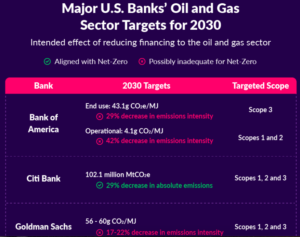
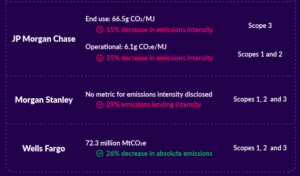
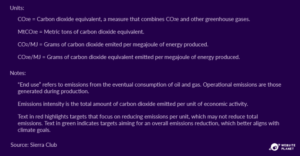
Of the six major US banks shown in the infographic, only Wells Fargo and Citigroup have made clear oil and gas sector targets that adequately align with the Paris Agreement’s mission to achieve net-zero emissions by 2050. The other four banks announced targets that focused on reducing oil and gas emission intensity rather than targets relating to absolute emissions. Emission intensity targets still allow for increasing investment into oil and gas, which diminishes the impact of these targets and makes it unclear whether or not this will suffice to achieve net-zero by 2050.
#38: Packaging Is Responsible for a Surprisingly High Share of E-commerce Emissions
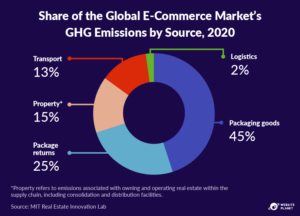
On the face of it, transport and logistics would seem to be the most likely cause for the majority of e-commerce emissions. However, this is far from the case, with packaging-level emissions accounting for nearly half of all emissions in the industry. One key driver of these packaging-level emissions is the production of plastic film packaging. According to analyst estimates, as much as 90% of these plastics are made from fossil fuels. And with online shopping becoming increasingly common each year, this trend isn’t likely to slow down — unless, of course, governments mandate greener packaging.
#39: Same-Day Delivery Is Becoming the New Norm
The global market for same-day delivery services is expected to double, growing from $7.93 billion in 2023 to $15.8 billion in 2027. This could be damaging for the environment. Studies show that same-day delivery increases emissions by up to 15%.
Over the last decade, and particularly since the COVID-19 pandemic, cultural expectations have shifted further toward the convenience of faster delivery times, including same-day delivery. Same-day shipping has a huge impact on emissions, as it forces delivery drivers to follow less efficient routes, opting instead for faster, poorly optimised routes.
In addition, this cultural shift also increases the frequency of mis-deliveries and returned items, causing more wasted journeys, and as a result, more emissions on their re-deliveries.
#40: More Delivery Vehicles Will Increase Traffic Congestion
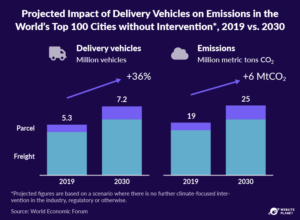
As a result of increased reliance by consumers on online shopping and fast turnaround, the number of delivery vehicles on the road is expected to continue to increase to meet demands. In addition to leading to a significant increase in carbon emissions, this is likely to lead to increased traffic, increasing the commute times of people living in these cities by up to 21%, as estimated by the World Economic Forum. Many of these delivery vans operate in congested inner city areas — and as a result, each time they pull over to make a delivery, they likely cause further congestion.
The Road to Lower Emissions
Having examined several current and past facts and figures about the tech industry and its emissions, in this section, we turn our attention forward. Let’s take a look at the outlook for the century ahead, and what needs to happen for global climate goals to be achieved.
#41: Global Fossil Fuel Consumption Is Likely to Go Up before It Comes Down
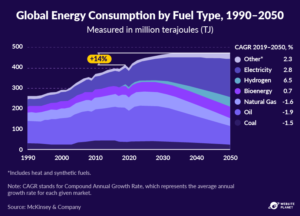
A 2022 study by McKinsey forecasts that before fossil fuel — oil, coal, and natural gas — consumption starts to decrease and be replaced over time with renewable energy sources, their consumption is actually likely to go up over the next few years, with a peak in the mid-2020s.
McKinsey also predicted that thanks to technology that enables more efficient use of electricity, by 2050 energy consumption is only going to be 14% higher than in 2019. This is certainly a positive forecast, but it requires that over the next decade, infrastructure for more renewable energy be put in place.
#42: The Paris Agreement Goals Are Still out of Reach
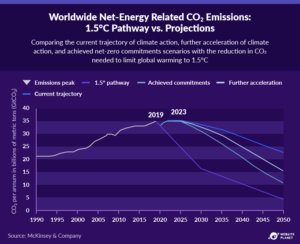
In the Paris Agreement, member nations pledged to limit the global rise in temperature to a 1.5C increase from pre-industrial averages. Currently, the average atmospheric increase is 1.2C over pre-industrial norms. The current emissions trajectory isn’t anywhere near where it needs to be to achieve climate goals, as per McKinsey’s forecast. Based on the world’s current path, the global mean temperature is most likely to increase by 1.7 – 2.4C by 2100, with a less likely scenario where temperatures increase even more.
#43: Net-Zero Pledges Have Quadrupled since 2019
How much of the global economy is committed to Net-Zero by 2050? The number was 16% in 1019, which increased exponentially to 70% in 2023.
Pledges to reduce emissions and eventually transition to net-zero are crucial steps in achieving climate goals. As more companies do, pressure is put on those that haven’t to follow suit. Emissions may go up before they go down, but on the whole, industries are making strides in the right direction.
As we venture further into the mid- and late-2020s, emission figures are likely to continue to look alarming. However, as long as mandates and infrastructure for a greener world are put in place, we may well be able to limit global warming to the 1.5C goal.
#44: Big Tech Companies Lead the Charge in Clean Energy Purchases in 2022
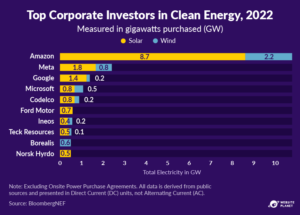
The amount of clean energy purchased every year is trending up, and rising exponentially. Over half the clean energy deals made in 2022 were signed by Big Tech giants Amazon, Meta, Google, and Microsoft. This is a significant step forward, as it signals their intention to clean up their emissions in the years to come, and strive to be net-zero by 2050 as per the Paris Agreement.
However, some of these companies still use dirty energy due to their office locations and their regional energy availability. To tackle this, over the coming years, they’ll need to relocate away from such regions to move entirely to greener energy.
#45: Mandatory Carbon Offsets Need to Be Higher
Mandatory offsets are legally required. They were valued at $44 billion globally in 2019. Voluntary offsets are optional. They were valued at $300 million in 2019. Voluntary offsets are purchased at a much lower rate than mandatory offsets. This indicates that individuals and corporations tend to do what’s required of them from a legal point of view, but don’t go the extra mile of their own accord — suggesting that mandating more offsets is the best way to bolster the offset market.
Carbon offsets tend to elicit mixed opinions, however — activists often disagree with the notion that environmentally damaging companies can be given an option to simply “throw money at the problem” and absolve themselves of any responsibility. It is undeniable that ideally, companies should buy offsets while also proactively mitigating their emissions. However, regardless of this, the offsets do help toward reducing carbon dioxide in the atmosphere.
#46: 5G Could Help Slash CO2 Emissions
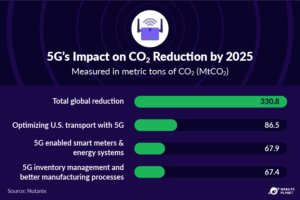
A report from Accenture found that 5G technology could be applicable in use cases far beyond consumer mobile networks, and can conceivably be used to optimise systems and networks. It suggests that using innovations like smart cities, optimised buildings, streamlined transport networks, and more efficient inventory stocks and manufacturing, all enabled by 5G technology, could reduce carbon dioxide emissions each year.
#47: The Decarbonisation Industry Is Growing Rapidly
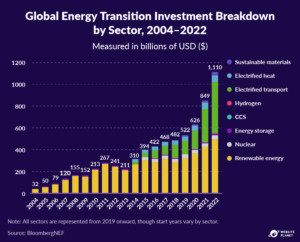
We’re starting to see massive — and growing — investments in technologies that enable large-scale shifts away from high-emission energy sources such as fossil fuels like coal and gas. Companies producing tech to remove or reduce carbon emissions are expected to reach a combined market value of $1.4 trillion by 2027, according to market research by Pitchbook, growing an expected 8.8% per year for the next four years. The green industry refers to companies focusing on decarbonising the industrial production of chemicals and raw materials, producing renewable energy, recycling, and decarbonising the atmosphere.
#48: Investors Back Clean Energy Tech amid Shaky Economy
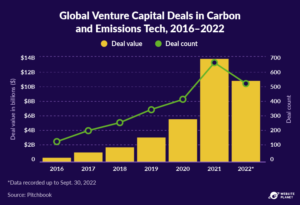
In 2022, the carbon and emissions tech sector, which encompasses startups developing technologies for carbon capture, storage, and emissions reduction, saw continued interest from investors. Venture capital funding amounted to $10.7 billion across 517 deals throughout the first three-quarters of the year, placing the industry on a path to equal 2021’s figures.
Among other programs, the Biden administration’s Inflation Reduction Act from 2022 is thought to have influenced a significant portion of this heavy investment. The legislation committed around $370 billion toward climate change, including subsidies for tech companies furthering that cause.
#49: Climate Fintech Could Help Raise the Bar Industry-Wide
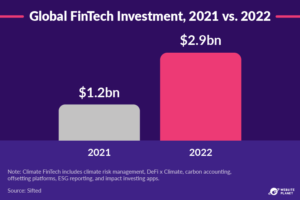
Climate fintech is an emerging niche within fintech, focusing on developing software and models that help companies achieve environmental goals. These include tracking their carbon emissions more accurately; providing climate risk management analytics; carbon offsetting; Environmental, Social, and Governance (ESG) reporting; impact investing (investing aimed at beneficial effects); and climate crypto (the use of crypto-technologies to drive action on climate change).
Carbon accounting (the measurement of how much greenhouse gas an organisation emits) is the category within climate fintech that attracts the lion’s share of investments in the space, taking nearly a third of all investment across climate fintech in the first half of 2022.
Looking Ahead
In terms of emissions, the last few decades have been a decidedly mixed bag — in the latter half of the 20th century, for the most part, both the tech industries and their emissions grew at a breakneck pace, with few companies showing much regard for keeping them under control.
However, in the last two decades in particular, increasingly many tech companies are showing great progress in curtailing their emissions — and more generally, signaling their intent to play their part in getting us on track to achieve the goals set out by the Paris Agreement.
The author, Tom Read, is a Content Manager for Website Planet who specialises in creating meaningful and insightful content. He’s researched, written, and edited numerous articles for Website Planet, including a comprehensive guide to NFTs. Underlined by his major in English Literature, Tom calls upon a decade’s worth of experience with content to help deliver value to readers.




